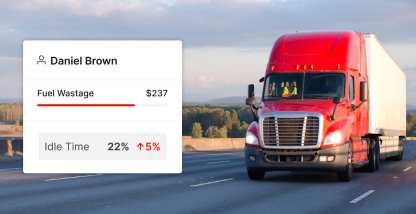Managing fleets is a complex task. It involves organizing operations, managing employees, maintaining fleet safety, taking care of administrative work, and much more. Simultaneously managing all these tasks efficiently can be difficult for fleet managers.
This is why so many fleet managers are excited about the upcoming ELD mandate and electronic logging devices.
ELDs are much more than just a tool for compliance. They provide valuable data, information, and insights that fleet managers can use to improve fleet operations. Moreover, because ELDs automate so many things, fleet managers can reduce many repetitive tasks and administrative burdens.
10 fleet management challenges that ELDs can solve
1. Establish real-time communication
Establishing and maintaining real-time communication is a major challenge for drivers and fleet managers.
A communication gap between drivers and fleet managers can cause delays in deliveries and disturb business operations. With ELDs and electronic logging mobile apps, fleet managers and commercial drivers can always stay in touch. They can avoid many potential problems through constant communication and updates.
2. Track vehicle location
Monitoring vehicle location is an important part of fleet management. From ensuring that the delivery would be in time to making sure that drivers are safe and on the designated routes, vehicle tracking has multiple benefits.
ELDs help fleet managers with a built-in GPS tracking system, so fleet managers are always aware of their fleet’s location.
The Motive ELD solution has a built-in GPS tracking system that provides the following features:
- It tracks vehicles with 1-minute updates.
- It shows vehicle location history with breadcrumb trails.
- It uses the GPS monitoring system with meter-level precision.
3. Improve fuel efficiency
Every carrier wants to reduce fuel wastage. However, without a proper fuel management tool, it becomes a big challenge for fleet managers to achieve that goal.
After all, if they don’t have access to the necessary data and insights, they can’t make improvements.
Electronic logging devices give fleet managers the required information they need to improve fuel efficiency. With features, such as idle-time tracking, fleet managers can identify drivers who idle too much or too frequently.
Moreover, by identifying and rectifying bad driving behaviors, such as hard acceleration and hard braking, a substantial amount of fuel can be saved. For instance, it is estimated that driving at 65 mph, instead of 55 mph, can consume up to 20% more fuel.
By using ELDs, fleet managers can solve one of the biggest fleet management challenges they have, i.e., reducing fuel wastage and improving fuel efficiency.
4. Reduce administrative burdens
ELDs can significantly reduce the administrative burden for fleet managers.
An ELD records vehicle data, updates duty status, communicates the fleet’s location, reports bad driving behavior and vehicle faults, simplifies roadside inspections, and generates driver performance scorecards. All these things assist fleet managers and lessen their burdens.
More importantly, ELDs minimize the reliance on paperwork and manual tasks. For instance, IFTA calculation is a huge administrative burden for fleet managers. They have to manually go through fuel receipts to calculate the IFTA tax and spend dozens of hours on it.
However, with ELDs, fleet managers can calculate IFTA reports in just a few clicks. It improves efficiency, reduces administrative burden, and save thousands of dollars that are spent on paperwork and labor four times a year.
Further reading: How to prepare IFTA reports in just a few clicks.
5. Improve driver retention
Driver retention is one of the biggest challenges faced by fleet managers nowadays. There is already a natural shortage of drivers in the industry. Moreover, not all drivers are happy with the upcoming ELD mandate.
Fleets that don’t transition to ELDs properly can suffer from a high driver turnover problem. Thankfully, ELDs help fleet managers with driver retention, too.
One of the biggest reasons drivers leave a company is because of driver harassment. The upcoming ELD mandate clearly protects drivers from harassment. Since everything is recorded automatically by ELDs, fleet managers can’t force drivers to break the law. As a fleet manager, it’d be your responsibility to educate your drivers about this provision and their rights.
Secondly, ELDs and electronic logging apps minimize the number of Hours-of-Service violations that drivers get. For instance, ELDs eliminate Form & Manner violations, falsification of logs violations, and outdated logs violations.
Also, roadside inspections are way quicker with elogs than they ever were with paper.
Quicker roadside inspections and fewer HOS violations mean fewer penalties, which mean more income for drivers.
Furthermore, since ELDs record data automatically, drivers can really focus on driving — without having to worry about maintaining logs or wasting hours with paperwork. They can earn more without getting driver fatigue.
All these factors significantly improve the driver retention rate — which is becoming a big problem in the trucking industry.
6. Rectificy dangerous driving behaviors
As mentioned earlier, some ELDs can help fleet managers with valuable data that they can use to rectify dangerous driving behaviors.
For instance, with Motive ELDs, fleet managers can see detailed reports on bad driving behaviors. It includes hard cornering, hard acceleration, and hard braking.
Fleet managers can identify drivers who drive dangerously and can arrange coaching sessions for rectifying their mistakes.
It is a great way to improve the safety of your fleet.
7. Get lower insurance premium rates
Insurance premium rates take into account many factors — from bad vehicle health to higher CSA scores. Carriers struggle to find companies that offer low premium rates.
ELDs can help get a lower insurance rate because:
- Vehicles with ELDs have a lower crash rate, as established by several studies. Fewer accidents and liabilities help in securing better insurance rates.
- ELDs manage driving habits by creating an accountability mechanism. Fleet managers can constantly keep an eye on how their drivers are driving. As a result, drivers drive responsibly. Good driving gets lower insurance premium rates.
- ELDs help achieve lower CSA scores, and lower CSA scores lead to lower insurance premiums.
Nowadays, if your fleet is equipped with ELDs, you will automatically get much better insurance packages from most insurance companies.
8. Manage roadside inspections
When drivers are preparing paper logs, mistakes are bound to happen. ELDs have solved this problem.
As the data is automatically recorded and generated for inspectors, the possibility of error is next to zero. Also, drivers won’t have to worry about bad handwriting, which eventually makes roadside inspections a breeze.
The Motive mobile app has a dedicated DOT inspection mode — which inspectors and drivers love. You can try the DOT inspection feature by download our free app on Android or iOS.
Recently, we have also introduced the DOT Inspection Mode Access Lock feature, which prevents DOT officers from accessing any personal information on the driver’s mobile devices.
9. Maintain vehicle health
ELDs also allow fault-code monitoring. Fleet managers can stay on top of any vehicle maintenance issue with real-time notifications whenever a fault is detected.
Moreover, fleet managers can also identify recurring vehicle problems with historical fault code reports. It allows fleet managers to take preemptive measures and intervene before the issue actually happens.
By automatically monitoring vehicle performance with the help of ELDs and without the need of regular physical inspections, fleet managers can save a lot of time and reduce their administrative burdens.
10. Improve fleet safety
Every fleet wants to be as safe as possible. There are valuable lives on the line.
Moreover, carriers strive to achieve the best CSA scores, minimize accidents, avoid HOS penalties, and maximize safety for drivers as well as for everyone else on the road.
ELDs help fleet managers achieve that desired level of safety.
With automatic logging and a tamper-free environment, ELDs ensure that drivers aren’t driving more than they are supposed to. Moreover, fleet managers can keep an eye on drivers’ performances and can intervene right away if they sense any problem.
Solve fleet management challenges with Motive
ELDs can help you solve various fleet management challenges. If you want to solve your unique fleet management challenges, request a free demo today.
The Motive ELD is affordable, easy-to-use, and packed with many fleet management features.









